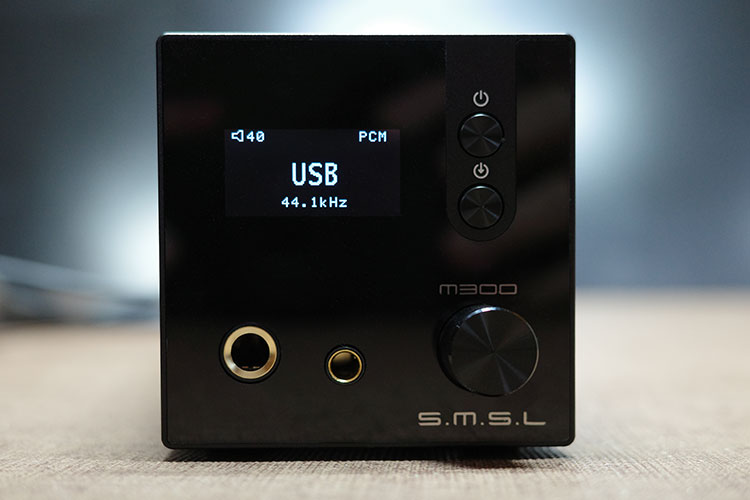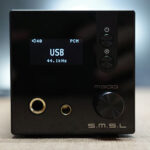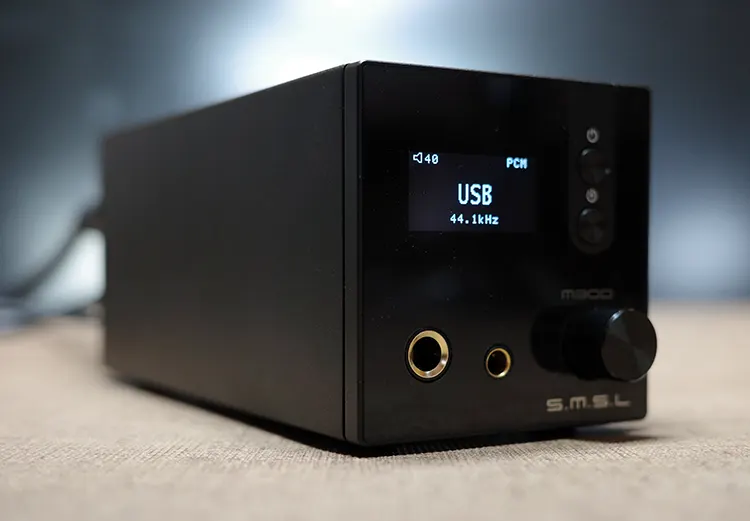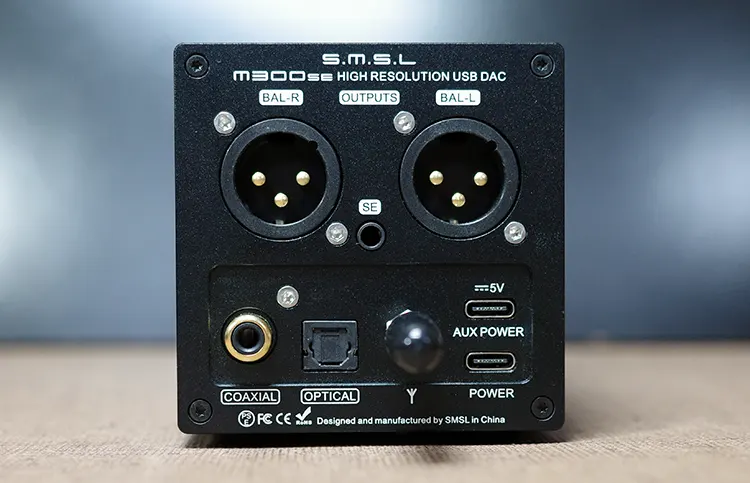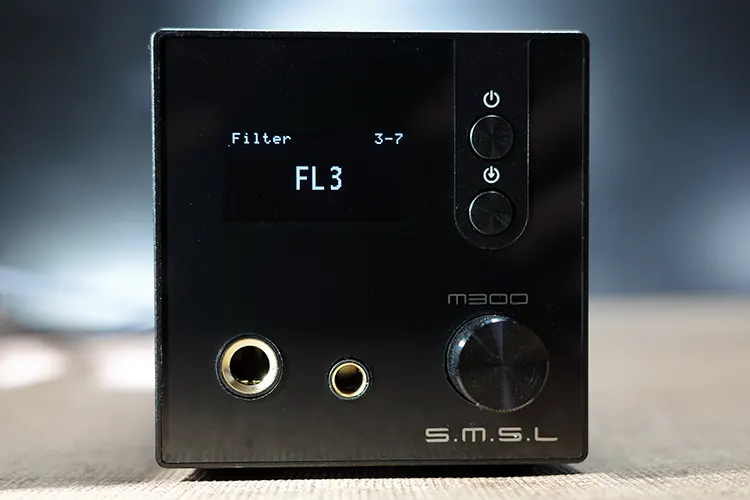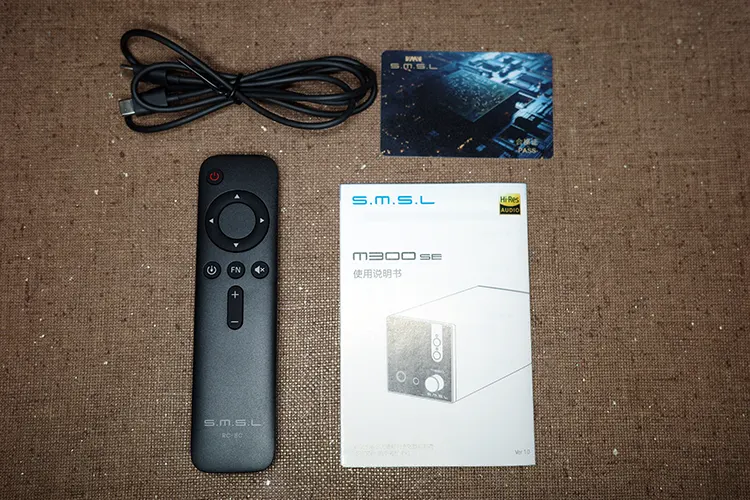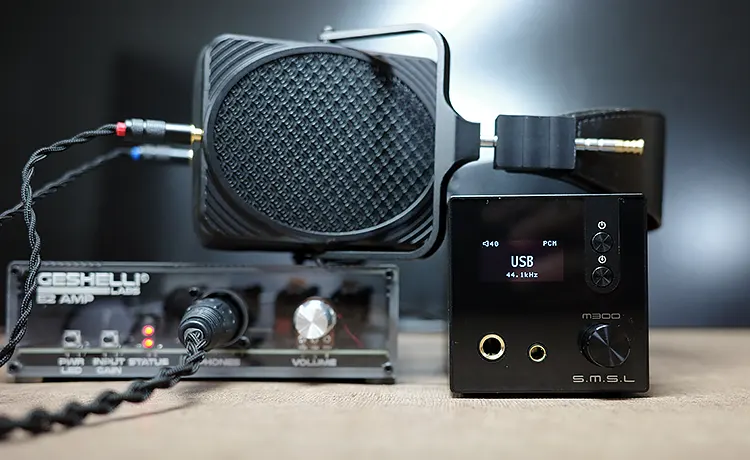Today, Lynn reviews the SMSL M300 SE, a compact and affordable desktop integrated dual DAC and balanced output headphone amplifier. It costs $129.99.
Disclaimer: I received this sample in exchange for my honest opinion. Headfonics is an independent website with no affiliate links or partnerships. I thank SMSL for their support.
Click here to learn more about the SMSL products we previously reviewed on Headfonics.
This article follows our current scoring guidelines which you can find in more detail here.
SMSL seemingly upgrades their products often. And as those improvements come about, quite often additions are made to the product, too. Incorporating items across many models makes perfect sense, while also giving each unit the ability to showcase on its own merits.
The $129.99 M300 SE is no different. It can be used as a standalone DAC, using the XLR output capabilities and with a similar form factor to the previously reviewed bigger sibling, the M500 MKII.
What I found when paired with a suitable amplifier such as the Geshelli Labs Erish2, the additions made for more than the sum. And that to me is what makes SMSL have another hit on their hands.
Features
Dual Cirrus Logic CS43131 DAC chips handle decoding. One of the first models to use the third-generation XMOS XU-316, the M300 SE supports PCM up to 32bit /768kHz and DSD512.
Bluetooth 5.0 is also included but only supports SBC. With an independent ultra-low clock, jitter and phase noise are kept low.
The output level of the SE RCA is 2.0 Vrms and 4.0 Vrms for the XLR outputs. The headphone output level is listed as 148mW which seems low.
No differentiation was had for whether that was the 3.5mm SE or 4.4mm balanced output because the M300 SE had no trouble driving any of my tested headphones.
USB supports full MQA decoding, and BT 5.0 wireless connectivity comes as standard. There is no power source, running off a USB-C connection, which can double as the input. To maximize noise reduction, the internal power system is discrete from the rest of the unit.
Design
The M300 SE’s design differs from most contemporary desktop DACs. Instead of the usual box shape, the M300 SE has a rectangular shape, which is square in two dimensions, and longer in depth. Fitting equally at home within your desktop system or hidden away between other components.
The front panel consists of a 1.29-inch OLED display, 4.4mm balanced, and 6.35mm single-ended headphone jacks. There is also a power button, an input select button, and a volume knob that doubles as a menu button/dial.
The back carries the balanced XLR outputs, a coaxial and optical input, a 3.5mm line out, Bluetooth antenna (run horizontally), a USB-C data port, and an additional USB-C port for an auxiliary power supply.
Weighing in at a little over 1/2kg, the unit is light though the matte-black color does tend to show fingerprints when carried.
I have come to appreciate the diminutive size of the M300 SE, allowing portability and ease of connecting to multiple sources, along with the unobtrusive placement.
I/O
Despite its modest price and diminutive size, the M300 SE is a fully balanced desktop DAC and amplifier. Accessing the menu, you can choose outputs from Line, Headphone, or a combination of both.
In addition, you can change the digital filter, adjust the display brightness, switch between variable and fixed-level output, and more.
The filter choices, numbered FL1-FL5 provide a personalization aspect like other DAC/Amps do. Access is by pushing the volume knob, which goes through various options.
FL1 provides a fast, low-latency filter for potential gaming. FL2 is a fast, phase-compensated filter for quick response. FL3 goes in the opposite direction with a slow low-latency filter.
FL4 is slow, phase-compensated for a more organic signature, and FL5 acts as the NOS (non-oversampling filter).
When choosing the “fixed” volume, the M300 SE acts like a pre-amplifier, which can then be hooked to an amplifier for control from there. The inclusion of a coax and optical makes for a good pairing with a CD player as I have in previous reviews.
The XLR-out allows for connecting a dedicated amplifier such as the Geshelli Labs Erish2 as I have also done in the past (and did here).
The volume knob uses detents and is not 100% accurate, sometimes requiring multiple turns to raise or lower the volume by one number.
Controls
The M300 SE uses the volume knob to move between “menus” as mentioned above. Pushing once allows you access to the input source options. Pushing twice gets you to the output submenu. Three times gets you to filter, where you turn the volume knob to adjust between your choices.
Four pushes of the volume knob get you to the screen dimmer, while five take you to the aforementioned pre-amp option with “fixed” volume or “variable,” which is normal operation. Six pushes take you to the brightness control of the screen, and seven is for BT connection, only.
The unit can be turned off using the top button on the front, saving battery power for the source connected. I found on my MPB I lost approximately five percent per hour in moderate volume usage.
Packaging & Accessories
The SMSL M300 SE comes in the now typical SMSL packaging, which consists of a black box with protective foam inserts inside.
Included with the USB-A to USB-C cable are the BT antennae (horizontal only to stay out of the XLR out connections), and a remote for control of all options (takes two AAA batteries).
Wireless Connectivity
Bluetooth connectivity was seamless to both my MBP and the HiBy R4. Using the M300 SE in BT mode allows you to listen using wired headphones or IEMs, with a variety of sources. The connection is one-way, so you cannot use TWS IEMs or wireless headphones together.
Latency may be the M300 SE’s biggest downfall. When playing YouTube videos, there was a discernible discrepancy between mouth movement and the sound coming through the listening device. This could also be that I was specifically watching for the difference, but it was noticeable.
I found this did not diminish my listening pleasure when playing music videos, since the delay was short enough to not distinguish regularly. And it could have easily been the video watched, as this did not occur on all that I played.
Wired Connectivity
USB-DAC
The easiest connection was using the included USB cable, which I tethered to my MPB. I also found a USB-C to USB-C cable, that I used for the rest of the testing for that source option.
Digital connections including the coax were used with the Oppo BDP83.
Pre-Amplifier
I used the M300 SE in pre-amp mode (DAC only) connected to the Geshelli Labs Erish2, through the (balanced) XLR-out connections. This allowed me to use headphones such as the Kennerton Rognir, and SJY Horizon through their XLR headphone cable.
Switching the volume to Fixed, allowed me to control volume from the Erish2.
Sound Impressions
All sound impressions were made using the AKG 240DF, Kennerton Rognir, Meze Audio 99 Classics, and SJY Horizon headphones along with the Kiwi Ears KE4, and Spirit Torino’s Twin Pulse Beryllium IEMs. Sources used were my MacBook Pro, the HiBy R4, Oppo BDP83, and tethered to the Geshelli Labs Erish2.
Summary
The SMSL M300 SE comes across as mostly neutral with good clarity and detail retrieval. I noted the quality was neither thin nor too thick until filter changes occurred. This was not unexpected. Vocals came across with sufficient weight to sound natural without becoming strident or too breathy.
Transparency was decent, but not outstanding. Using the M300 SE either singularly or tethered to the Erish2 provided good to excellent layering (better combined with the Erish2).
Bass
The low end is controlled with a tight grip on the sound, without becoming too clenching, while still running deep. Due to the nearly neutral signature, it does not become exaggerated or bleed into the mids.
The low end allows tight control over percussion instruments such as the bass drum, which comes across as persuasive behind the scenes.
Bass guitars play their supportive role in much the same manner, allowing the foundation to set the tone, but not influence its overall character in an intrusive manner.
Mids
The mids come across as clear with a good body. There is no bass bleed into the lower midrange, unlike a more expensive DAC I just finished.
The M300 SE reveals good texture to the note weight without becoming gritty or grating. That natural tendency carries over here, presenting vocals and string instruments in a very natural, organic manner.
Organic in this case means without coloration or artificiality in context, instead of a smoothing in character. The finer details can be readily heard as a result.
Treble
There is good air to the notes up top, and this is one of the better Cirus Logic treatments I have heard of late. The same chips in a comparable DAC, do sound a bit different. Notes come across as crisp with good definition.
That air antithetically carries good volume to the note characteristics with a spaciousness to them, adding to the good breathiness I mentioned above.
I find this area completely listenable for long periods, and I never tired of the signature, even on music that emphasizes the upper reach frequencies.
Staging & Dynamics
There is good weight to the notes providing a solid foundation, but also an airy note that allows the spaciousness to carry equally well across all three dimensions.
That open character allows the notes to spread across the space, defining layers with a succinct character, without becoming too finely defined.
This speed of action does not diminish the quality when put together as a whole but rather ties the signature together in a swirling mass of coherence instead.
The height attained allows the layers to distinguish themselves nicely but without too much differentiation. The flowing nature of the overall character connects the separates into a smooth(er) representation, that remains vibrantly neutral.
The flowing nature mentioned above allows the neutrality to carry the tune with alacrity. There is nothing too forward, too vibrant, or too boring about the mix when putting this all together.
Side-to-side differentiation carries that theme too, with a distinctness to it that allows placing instruments accurately not only in layering but across the stage. A slight out-of-head experience both in width and depth affords the sound to persist musically across the spectrum.
Click on page 2 below for my recommended pairings and selected comparisons.

